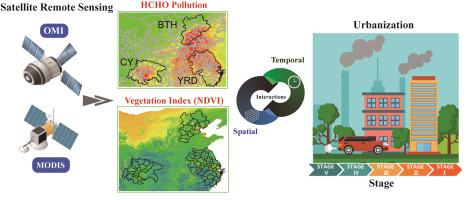揭示近几十年来中国特大城市植被覆盖对大气甲醛污染的时空影响
IF 7.3
2区 环境科学与生态学
Q1 ENVIRONMENTAL SCIENCES
引用次数: 0
摘要
城市植被覆盖被广泛推广以改善宜居性和减少污染物暴露,但其对空气质量的影响仍存在争议。甲醛(HCHO)主要通过人为和生物源性挥发性有机化合物的氧化形成,具有重大的健康风险,是O3和PM2.5的前体。在这里,我们研究了2005-2017年中国特大城市城市化阶段的城市植被覆盖与HCHO的关系。我们将每月的OMI/Aura HCHO列、基于modis的归一化植被指数(NDVI) (250 m)和landsat衍生的景观指标整合在一个统一的0.1网格上。通过z得分指标(人均GDP、人口密度、建成率和夜灯)的k均值将城市分为五个城市化类别,k = 5由肘形、轮廓和Calinski-Harabasz标准支持。使用SRCC评估NDVI与HCHO之间的相关性,并使用地理加权回归(GWR)评估空间异质性。在各个阶段,NDVI-HCHO相关性从V级的弱阴性(SRCC = - 0.09, p < 0.001)转变为III级的强阳性(SRCC = 0.81, p < 0.001),然后在II级和I级减弱(0.63和0.72)。从区域上看,北京和长江三角洲NDVI(3.29%和5.94%)和HCHO(22.53%和8.7%)同时上升,而长江三角洲NDVI上升10.18%,HCHO下降9.74%。GWR强调LPI是跨阶段HCHO变异性的稳健结构预测因子。这些模式与BVOC势、人为VOC/NOx和气象学之间的环境依赖相互作用一致。我们的研究结果提醒我们不要一刀切的绿化:城市植被覆盖的空气质量结果取决于城市化阶段和景观配置。在城市化程度较高的环境中,差异化规划和控制人为前体,以及优化III类“峰值关联”周围的植被类型/斑块结构,可以更好地将绿化与HCHO缓解结合起来。本文章由计算机程序翻译,如有差异,请以英文原文为准。

Unveiling the Spatial and Temporal Effects of urban vegetation coverage on Atmospheric Formaldehyde Pollution in Chinese Megacities over Recent Decades
Urban vegetation coverage is widely promoted to improve livability and reduce pollutant exposure, yet its air-quality effects remain debated. Formaldehyde (HCHO), formed largely via oxidation of anthropogenic and biogenic VOCs, poses significant health risks and is a precursor of O3 and PM2.5. Here we examined how urban vegetation coverage was associated with HCHO across urbanization stages in Chinese megacities during 2005–2017. We integrated monthly OMI/Aura HCHO columns, MODIS-based Normalized Difference Vegetation Index (NDVI) (250 m), and Landsat-derived landscape metrics, harmonized on a common 0.1 grid. Cities were grouped into five urbanization classes via k-means on z-scored indicators (GDP per capita, population density, built-up ratio, and nightlights), with k = 5 supported by elbow, silhouette, and Calinski–Harabasz criteria. Associations between NDVI and HCHO were assessed using SRCC and spatial heterogeneity was evaluated with Geographically Weighted Regression (GWR). Across stages, the NDVI–HCHO association shifted from weakly negative in Class V (SRCC = −0.09, p < 0.001) to strongly positive in Class III (SRCC = 0.81, p < 0.001), then weakened in Classes II and I (0.63 and 0.72). Regionally, BTH and YRD showed concurrent increases in NDVI (3.29% and 5.94%) and HCHO (22.53% and 8.7%), whereas CY experienced a 10.18% NDVI rise but a 9.74% HCHO decline. GWR highlighted LPI as a robust structural predictor of HCHO variability across stages. These patterns are consistent with context-dependent interactions among BVOC potential, anthropogenic VOC/NOx, and meteorology. Our results caution against one-size-fits-all greening: the air-quality outcome of urban vegetation coverage depends on urbanization stage and landscape configuration. Differentiated planning and controlling anthropogenic precursors in more urbanized settings and optimizing vegetation type/patch structure around the Class III "peak association" can better align greening with HCHO mitigation.
求助全文
通过发布文献求助,成功后即可免费获取论文全文。
去求助
来源期刊

Environmental Pollution
环境科学-环境科学
CiteScore
16.00
自引率
6.70%
发文量
2082
审稿时长
2.9 months
期刊介绍:
Environmental Pollution is an international peer-reviewed journal that publishes high-quality research papers and review articles covering all aspects of environmental pollution and its impacts on ecosystems and human health.
Subject areas include, but are not limited to:
• Sources and occurrences of pollutants that are clearly defined and measured in environmental compartments, food and food-related items, and human bodies;
• Interlinks between contaminant exposure and biological, ecological, and human health effects, including those of climate change;
• Contaminants of emerging concerns (including but not limited to antibiotic resistant microorganisms or genes, microplastics/nanoplastics, electronic wastes, light, and noise) and/or their biological, ecological, or human health effects;
• Laboratory and field studies on the remediation/mitigation of environmental pollution via new techniques and with clear links to biological, ecological, or human health effects;
• Modeling of pollution processes, patterns, or trends that is of clear environmental and/or human health interest;
• New techniques that measure and examine environmental occurrences, transport, behavior, and effects of pollutants within the environment or the laboratory, provided that they can be clearly used to address problems within regional or global environmental compartments.
 求助内容:
求助内容: 应助结果提醒方式:
应助结果提醒方式:


